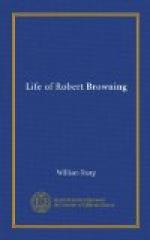VOL. II.
A Blot in the ’Scutcheon, and other Poetic Dramas,
by Robert Browning.
With an Introductory Note by Frank Rinder.
VOL. III.
Dramatic Romances and Lyrics; and Sordello, by Robert
Browning.
To which is prefixed an Appreciation of
Browning by Miss E. Dixon.
* * * * *
BINDINGS.
The above volumes are supplied in the following Bindings:—
IN GREEN ROAN, Boxed, with Frontispiece in Photogravure,
2s. 6d. net.
IN ART LINEN, with Frontispiece in Photogravure, 2s.
IN WHITE LINEN, with Frontispiece in Photogravure,
2s.
IN BROCADE, 2 Vols., in Shell Case to match (each
vol. with Frontispiece),
price 4s. per Set, or 3 vols.
6s. per Set.
And in the ordinary SHILLING BINDINGS, Green Cloth,
Cut Edges, and
Blue Cloth, Uncut Edges (without
Photogravure).
* * * * *
The Three Volumes form an admirable and representative “Set,” including a great part of Browning’s best-known and most admired work, and (being each of about 400 pages) are among the largest yet issued in the CANTERBURY POETS. The Frontispiece of Vol. I. consists of a reproduction of one of Browning’s last portraits; Mr. RUDOLF LEHMANN has kindly given permission for his portrait of Browning to be reproduced as a Frontispiece of Vol. II.; while a reproduction of a drawing of a View of Asolo forms the Frontispiece of the third Volume.
New and Enlarged Edition, Crown 8vo, Cloth, 6s.
MODERN PAINTING,
By GEORGE MOORE.
* * * * *
SOME PRESS NOTICES.
“Of the very few hooks on art that painters and critics should on no account leave unread this is surely one.”—The Studio.
“His book is one of the best books about pictures that have come into our hands for some years.”—St. James’s Gazette.
“If there is an art critic who knows exactly what he means and says it with exemplary lucidity, it is ‘G.M.’”—The Sketch.
“A more original, a better informed, a more suggestive, and let us add, a more amusing work on the art of to-day, we have never read than this volume.”—Glasgow Herald.
“Impressionism, to use that word, in the absence of any fitter one,—the impressionism which makes his own writing on art in this volume so effective, is, in short, the secret both of his likes and dislikes, his hatred of what he thinks conventional and mechanic, together with his very alert and careful evaluation of what comes home to him as straightforward, whether in Reynolds, or Rubens, or Ruysdael, in Japan, in Paris, or in modern England.”—Mr. Pater in The Chronicle.
“As an art critic Mr. George Moore certainly has some signal advantages. He is never dull, he is frankly personal, he is untroubled by tradition.”—Westminster Gazette.




